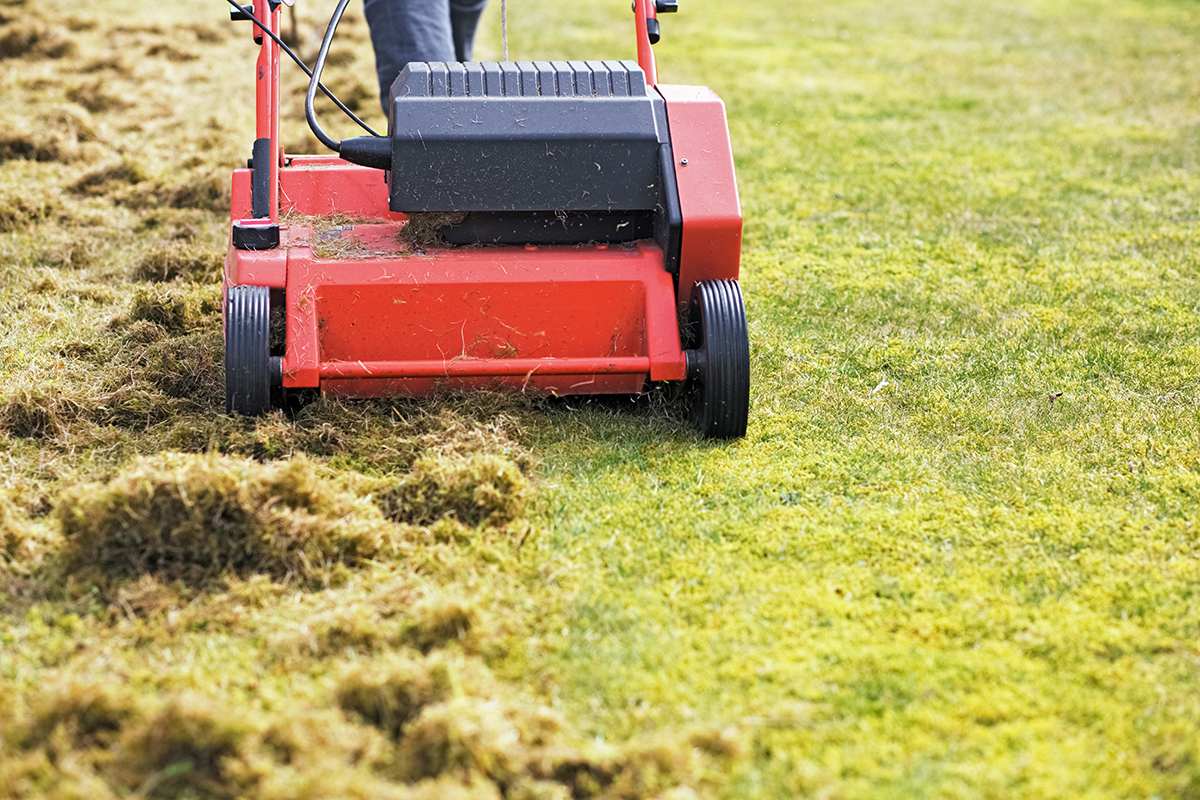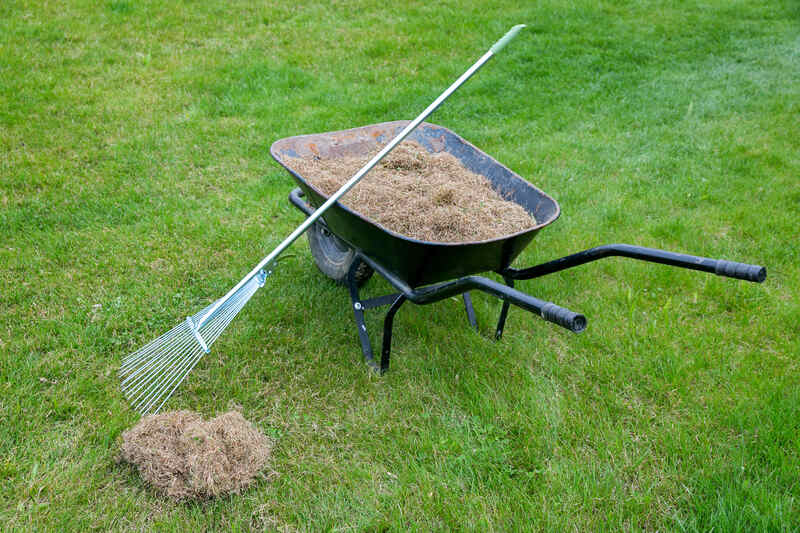
Dethatching is the process of removing the plant matter that accumulates between the soil and the grass (the thatch layer). You can dethatch manually, using a thatching rake, or mechanically, with a verticutter.
Understanding Lawn Thatch
Thatch is the layer of plant matter that sits between the grass and the soil. It is made out of living and dead grass blades, roots, rhizomes, and stolons. Lawn thatch starts to build up when your grass produces organic matter faster than it can break it down.
These common environmental factors and maintenance practices favor excessive thatch production:
- Some grass species are naturally prone to thatch production.
- Excessively acidic soils decrease the number of microorganisms that help break down organic matter.
- Some pesticides affect earthworms, and some fungicides increase the production of roots and rhizomes if used repeatedly over several years.
- Excessive fertilization stimulates the production of roots and stems, and some can also acidify the soil.
A certain amount of thatch is expected and even healthy for your lawn. So when does thatch become a worry? Thatch starts to become a problem once it reaches 1/2 inch or more. Some signs of excess thatch in your lawn include:
- Soil with a “spongy” feeling when you walk on it
- Frequent problems with lawn diseases and lawn pests
- Bare spots or areas with browing turf
How Dethatching Works
Dethatching is the process of removing excess thatch. This process is done by using a manual thatching rake or a vertical mower (also known as a power rake or verticutter). Both dethatching methods work by cutting through the soil to loosen the thatch layer and dig out pieces of it, helping water, nutrients, and air penetrate the soil.
- Thatching rakes are usually sufficient to dethatch smaller yards or small sections of the yard. These rakes have stiff blades so when you pull the rake through the turf, they dig into the soil and bring the thatch layer up to the surface.
- Vertical mowers, also known as verticutters or power rakes, are machines similar to regular mowers. However, as the name suggests, they have vertical blades (or tines) that cut through the thatch layer multiple times.
Check out our guide on How to Dethatch Your Lawn for step-by-step instructions.
If you’re looking for someone to dethatch your lawn for you, contact one of our LawnStarter lawn care pros. We have lawn care experts near you who are eager to offer a helping hand.
When to Dethatch
The best time to dethatch your lawn is during your turf’s growing season. For warm-season grasses, the best time to dethatch is from late spring to early summer. For cool-season turf, dethatch during early spring or late summer/early fall.
How Often Should I Dethatch My Lawn?

It depends on your environmental conditions and turfgrass type. A good rule of thumb is to dethatch annually, or at least check for thatch once a year. If the thatch layer is 1/2 inch or more, it’s time to dethatch.
Why it’s Important to Dethatch
Dethatching your lawn is important to allow nutrients, air, and water to properly reach the soil and, consequently, prevent the problems that excessive thatch creates: lawn diseases, lawn pests (mole crickets are especially fond of thatchy lawns), impaired root growth, and discolored areas throughout the lawn.
Some important benefits of dethatching the lawn include:
- Improves root growth and air circulation
- Prevents lawn diseases and pests
- Reduces weeds
- Better sunlight penetration and water drainage
How Can I Prevent Excessive Thatch Buildup?

Choosing the right grasses and following good lawn care maintenance practices are the best ways to prevent excessive thatch in your lawn:
- Choose grasses that are less prone to thatch: Grass species that spread through both rhizomes and stolons (like Kentucky bluegrass and warm-season grasses) are typically prone to thatch production, while bunch-type grasses (like tall fescue and perennial ryegrass) produce less or no thatch at all.
- Test your soil pH: Use a soil test kit to monitor your soil pH, as overly acidic soils have fewer microorganisms that help decompose thatch. A soil test report will tell you if your soil pH is balanced or not, and most will include a lime recommendation to fix your pH, if needed.
- Aerate regularly: Aerating your lawn is an important part of your lawn care routine if you want to prevent thatch, as it improves airflow and relieves soil compaction.
- Avoid over-fertilizing: Over-fertilizing (using excessive amounts of nitrogen or fertilizing your lawn too many times during the year) can end up stimulating thatch growth. Similarly, avoid using pesticides that can affect earthworm populations.
| If you want help with tasks that require handling heavy machines, such as lawn aeration, contact a lawn aeration pro from LawnStarter to help you out. Our customers spend an average of $362 for aeration plus overseeding on a small lawn. |
FAQ
Yes, you can dethatch your lawn yourself using a dethatching rake or a verticutter. You can also rent a verticutter at your local equipment rental store or purchase one. (Take a look at our reviews on the best power rakes of the year to choose the right one for you.)
Additionally, if your lawn is too large or you’re having a hard time doing the job on your own, you can always count on our lawn care experts.
See Related: What is Verticutting?
Professional lawn dethatching services cost between $65 and $165, on average, for a small lawn.
After dethatching your lawn, you can take the opportunity to aerate, overseed, fertilize, and water your lawn according to your turf’s needs.
See Related: What to Do After Dethatching Your Lawn
When to Call a Pro to Dethatch Your Lawn
Dethatching can be a labor-intensive task, so if you’re short on time or simply not in the mood to get your hands dirty, contact a LawnStarter lawn care pro. Get a free quote today.
Sources:
- “How to Control Thatch in Your Lawn.” by Sam Bauer, Extension educator, Deborah Brown, and Don Taylor. University of Minnesota Extension.
- “Managing Thatch in Lawns.” by Peter Landschoot, former professor of Turfgrass Science at Pennsylvania State University.
- “The UC Guide to Healthy Lawns – Dethatching.” University of California.
- “The UC Guide to Healthy Lawns – Dethatching Methods.” University of California.
Main Image Credit: Shutterstock